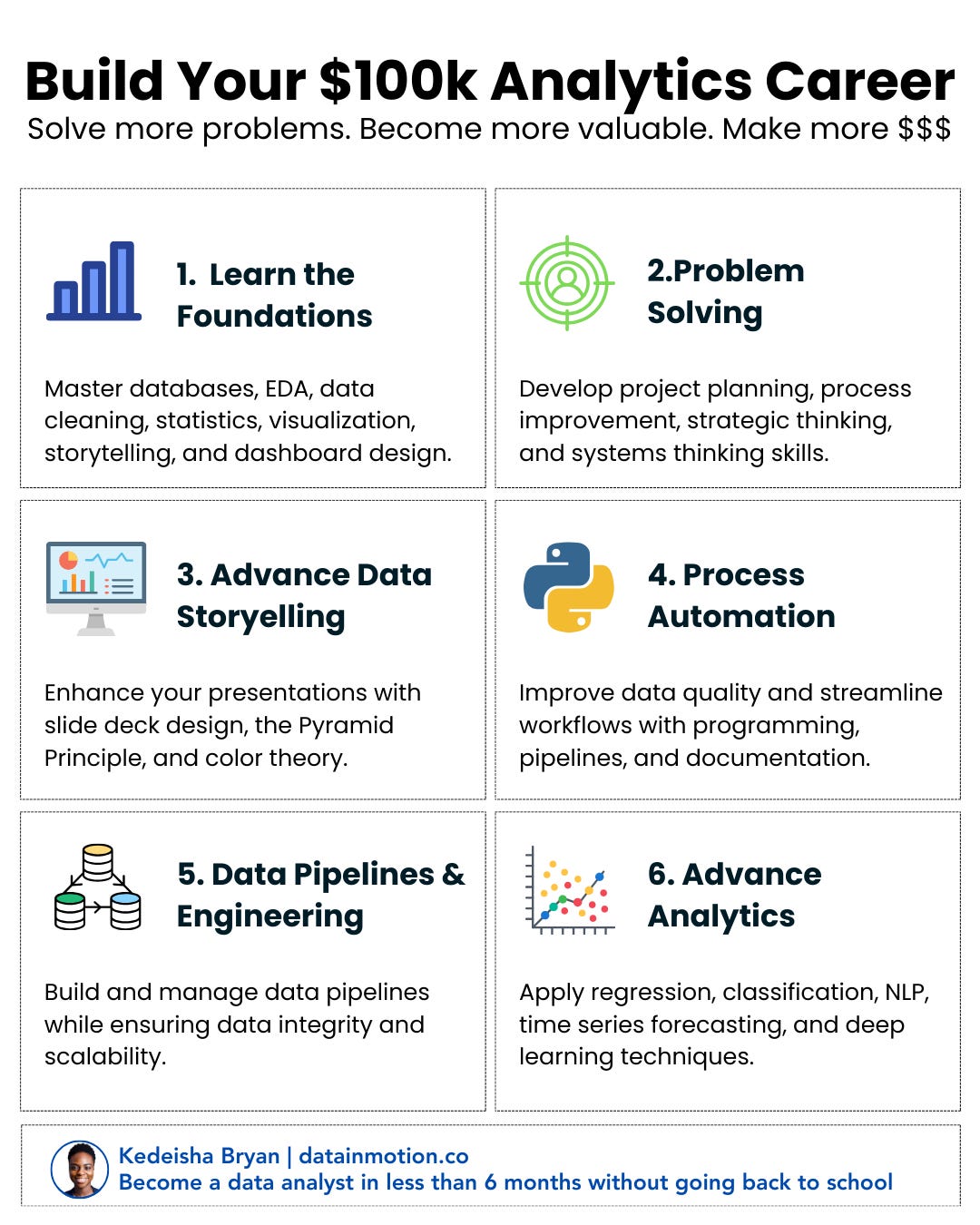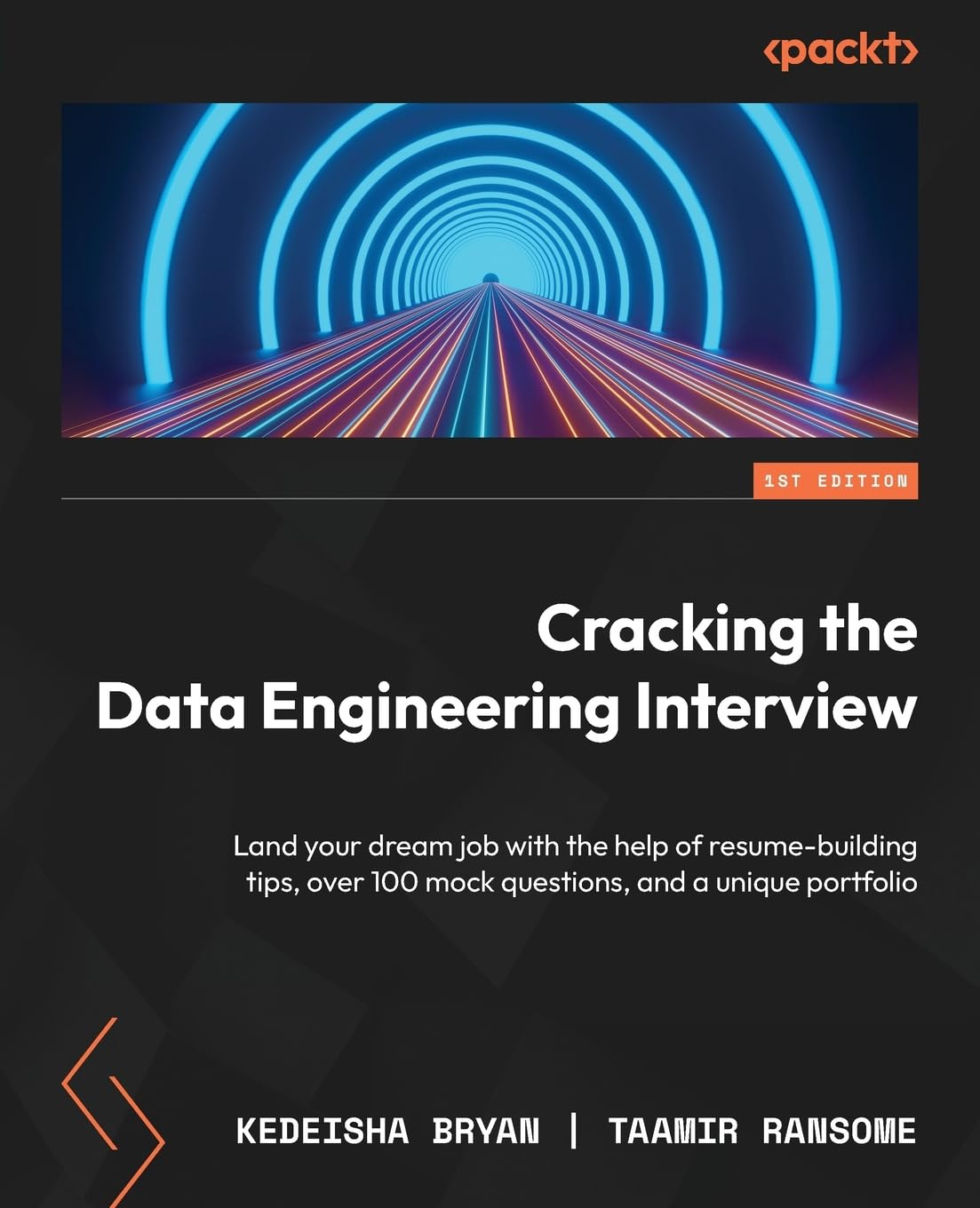Becoming a Full-Stack Data Analyst
Master these skills to increase your value, grow your income, and never get left behind in tech again.
Skill stacking is how you build career security—period.
No one’s handing out job security in today’s market. If you want it, you build it brick by brick through your skills.
Not by getting another degree.
Not by downloading more free PDFs.
But by getting real-world ready—and staying that way.
I built my own six-figure data career from the ground up, and here’s what I learned: the people who stay relevant are the people who never stop learning.
They don’t wait for someone to tell them what to learn next—they’re already on to the next thing.
I’ve helped thousands of career changers land analyst roles by pushing this exact mindset. You’ve got to become what companies actually want to hire: full-stack data analysts who solve problems, not just execute tasks.
And that’s why I don’t just hand my students a curriculum. We go deeper.
Weekly skills challenges
Live business-driven projects
Portfolio critiques
Weekly 1:1 coaching
Because I know the market doesn’t care what course you finished. It cares what you can do.
If you want to build a high-leverage career in data, here’s the roadmap. Follow these six steps, in order, and don’t skip a single one.
First, master the foundations
This is your base. Your toolbox.
The stuff every hiring manager expects you to know without even asking. I’m talking Excel, SQL, Tableau or Power BI, visualization, data manipulation, and basic statistics.
You need to be able to slice and dice data, clean it, and get it into a format where insights can happen.
Can you build a pivot table?
Write a CASE WHEN in SQL?
Use subqueries and CTEs?
Design a dashboard that tells a story without you speaking?
If not, that’s your first stop.
And let me be clear: mastering the foundations doesn’t mean watching tutorials.
It means doing. Practicing. Running your own analyses on real-world datasets.
Posting those projects. Showing your work. Showing your excellence.
Step 2: Learn Problem-Solving Frameworks
Here’s the truth: analysts don’t get paid to answer questions.
We get paid to ask better ones.
Anyone can build a chart. But can you walk into a messy business problem and untangle it?
But can you define KPIs, form a hypothesis, and know what metrics actually matter?
That’s problem-solving.
Frameworks like DMAIC, 5 Whys, the analytics lifecycle, or even simple root cause analysis give your work structure.
Most new analysts skip this and then wonder why their dashboards fall flat.
Don’t just become a tool operator. Become a thinker.
Step 3: Become a Storytelling Junkie
Data storytelling isn’t optional anymore—it’s a power skill.
Companies don’t want dashboards. They want decisions.
And decisions are made when someone connects the dots and says, “Here’s what this means, and here’s what we should do.”
Your visuals should drive action.
That means using the right chart type, simplifying clutter, and guiding your audience’s eyes to what matters most.
I teach my students to structure every story around business context, insight, and action.
Nail that, and suddenly you’re not “just an analyst.” You’re a trusted advisor.
Step 4: Learn Python to Automate Repetitive Tasks
Let’s talk leverage. Python lets you go from manual to magical.
Cleaning spreadsheets by hand?
Writing the same SQL query ten times?
Python says, “We’re not doing that anymore.”
You don’t need to be a software engineer.
You just need enough Python to automate the repetitive stuff:
cleaning data
building basic reports
analyzing patterns
scheduling workflows
automating data pipelines
This alone can save you (and your stakeholders) hours each week—and make you way more valuable to your team.
And yes, you can learn this without a computer science degree.
I did. My students do it every week.
Step 5: Educate Yourself on Data Engineering
Most analysts have no idea where their data comes from—and it shows.
They get stuck when something breaks upstream. They don’t know how to debug it or explain what’s wrong.
But if you understand the basics of how data flows—from source systems, through pipelines, into warehouses and tools—you become a different kind of analyst.
You’re no longer dependent. You’re collaborative.
You can speak to engineers.
You can spot data quality issues before they cost the company money.
You don’t need to be building Airflow pipelines.
But you do need to understand what a pipeline is, what ETL means, and how your tools plug into that system.
Step 6: Learn Advanced Analytics
This is where the serious impact happens.
Once you’ve got the foundations, problem-solving, storytelling, and automation down, it’s time to start predicting, segmenting, and optimizing.
Advanced analytics means asking better questions and getting deeper insights.
It’s where you apply things like cohort analysis, customer segmentation, time series forecasting, or even basic regression models.
This is what turns you into a strategic asset—not just a reporting tool.
Most people never make it to this step.
They stop at dashboards.
But if you want to grow your income, your influence, and your career options, this is the level you need to reach.
Don’t skip steps. Don’t fake it. Don’t rush the process.
Because this path? It works. I’ve walked it. I’ve taught it.
I’ve seen it change lives.
And if you stay consistent and keep leveling up, there’s no limit to where this can take you.
The more you learn, the more you earn.
It’s not a slogan. It’s a fact.
How many of these six steps have you already mastered?
Reply with a number. Let’s find your baseline—and what your next move should be.
Want to become a data analyst in the next 6 months? Let’s make it happen.
If you're serious about leaving your old career behind and stepping into a high-paying, high-impact role in data, I want to personally invite you to apply for the Data Career Launch Program.
This isn’t another course you forget about after week two.
This is a done-with-you, high-touch coaching experience built for career changers who want results—and fast.
We’ve helped professionals pivot from all kinds of backgrounds—warehouse workers, teachers, cashiers, truck drivers, human resources—and land analyst roles in under 6 months.
Like Jacinda.
She came to us as a truck driver. In just a few months, she was working as a process analyst at Hyundai.
If you’re willing to show up and do the work, we’ll meet you with the strategy, coaching, and structure to get you across the finish line.
Here's what you get:
A full step-by-step roadmap—no guesswork
1:1 support from me and my team of senior data professionals
Personalized portfolio and resume help
Mock interviews and job search coaching
Lifetime access to the Data in Motion Academy
You don’t need another degree. You need a plan—and a team that won’t let you fall off track.






